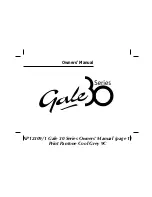
TIG130HF - 1 - 230204
p
p
WARNING! Use welding head shield to protect eyes and avoid exposing skin to ultraviolet rays given off by electric arc. Wear safety welding gauntlets.
If difficult welds are to be performed and the welding parameters are unknown, it is advisable to carry out several trial runs on test pieces in order to
determine the right welding current and gas flow.
8.7
SWITCH ON
the welder only when you are satisfied that the welder is correctly connected and the work to be done is fully prepared.
Setting the controls.
8.8
Select the right hand position on the miniature toggle switch ( see fig.2.2 ) on the front panel which is the arc welding mode.
8.9
Set the welding current required.
8.10
Striking the arc.
Strike the electrode tip on the workpiece as if you were striking a match. ( Do not hit the electrode on the workpiece as this
could damage the electrode and make strike-up difficult. )
8.11
Welding.
As soon as the arc is ignited try to maintain a distance from the workpiece equal to the diameter of the electrode in use and maintain this distance
throughout the duration of the weld. Remember that the angle of the electrode as it advances should be 20 to 30
O
from a vertical line over the workpiece.
8.12 At the end of the weld bead, move the electrode backwards in order to fill the weld crater and then quickly lift the electrode from the weld pool in order to
extinguish the arc.
8.13
SWITCH OFF
the welder after use.
9.
MAINTENANCE
10. TROUBLESHOOTING
s
s
DANGER! Unplug the inverter from the mains power supply before connecting or disconnecting cables or performing maintenance or service. Direct
contact with the inverter circuit is dangerous.
9.1
To avoid a build up of dust inside the machine which may block or restrict the ventilation system, periodically remove the covers and remove the dust with a
low pressure air jet or vacuum cleaner. Replace covers immediately. Under no circumstances should the machine be operated with the covers removed.
9.2
TORCH. Avoid resting the the torch and its associated cable on any hot surfaces. If the insulation is damaged in any way the torch cannot be used.
9.3
Periodically check the condition of the gas tubing and the connections.
9.4
In the event of any problems of unsatisfactory weld performance please first go through the trouble shooting procedure shown below. If this does not solve
the problem the Inverter must be taken to a qualified and authorised service agent for repair. Contact your local Sealey dealer for service.
TIG WELDING
10.1
Yellow fault indicator is illuminated.
When this LED indicator is on the current has been shut off for one of the following reasons:-
a) Inverter has overheated.
Leave the machine to cool to normal temperature at which point it will reset itself automatically. Do not restart the inverter
until the reason for overheating has been understood and solved. ( see below )
b) Voltage is too high or too low.
If the supply voltage drops below 190V AC or rises above 260V AC the machine is turned off.
Reconnect the inverter to
a more stable supply of 230V AC.
c) Short circuit has occurred.
If a short circuit has occurred lasting more than 1.5 seconds ( e.g. during the striking of the arc ) the inverter is switched off.
In this case, wait for the inverter to restart automatically.
10.2
Overheating.
This may occur for one of the following reasons : -
a) Inverter casing is full of dust making cooling system inefficient.
Clean as described in section 9.1.
b) Fan not working.
Have fan renewed by authorised service agent.
c) Electrode does not match the collet and collet body fitted within the torch.
Obtain and fit the correct size of torch components for the electrode selected.
d) Bad connection in welding cable and/or work clamp has made poor connection with work piece.
Check and clean all connections..
10.3
Poor weld quality.
a) Refer to weld bead diagrams.
b) Check condition of electrode. It should be ground
to the correct shape as seen in section 4.4 and
should be symmetrically conical.
c) Check that correct gas flow is being used.
d) Check that correct ceramic nozzle is fitted to torch.
10.4
Difficulty in striking an arc.
This is usually due to the electrode not being in good
condition. Grind to correct shape or replace.
ARC WELDING
10.5
Burning through thin metal:
On very thin sheet, e.g. car body work, the lowest amperage setting may be too fierce. In this case revert to TIG welding.
10.6
Machine cuts out:
Refer to fault indicator information above.
10.7
Difficulty in striking an arc:
a). The electrode is damp. Heat it up to 60º - 70º before using.
b). Wrong type of rod.
Declaration of Conformity
We, the sole importer into the UK, declare that the product listed below is in conformity with the following EEC
standards and directives.
The construction file for this product is held by the Manufacturer and may
be inspected, by a national authority on request to Jack Sealey Ltd
For Jack Sealey Ltd. Sole importer into the UK of Sealey Power Welders
23rd February 2004
Signed by Mark Sweetman
INVERTER Model TIG130HF
Low Voltage Directive (S.I. 1994/3260) 73/23/EEC
EMC Directive (S.I. 1992/2372) & Amendments.
89/336/EEC
NOTE:
It is our policy to continually improve products and as such we reserve the right to alter data, specifications and component parts without prior notice.
IMPORTANT:
No liability is accepted for incorrect use of this equipment.
WARRANTY:
Guarantee is 12 months from purchase date, proof of which will be required for any claim.
INFORMATION:
For a copy of our latest catalogue and promotions call us on 01284 757525 and leave your full name and address including your postcode.
01284 757500
01284 703534
Sole UK Distributor
Sealey Group,
Bury St. Edmunds, Suffolk.
www.sealey.co.uk
Web

























